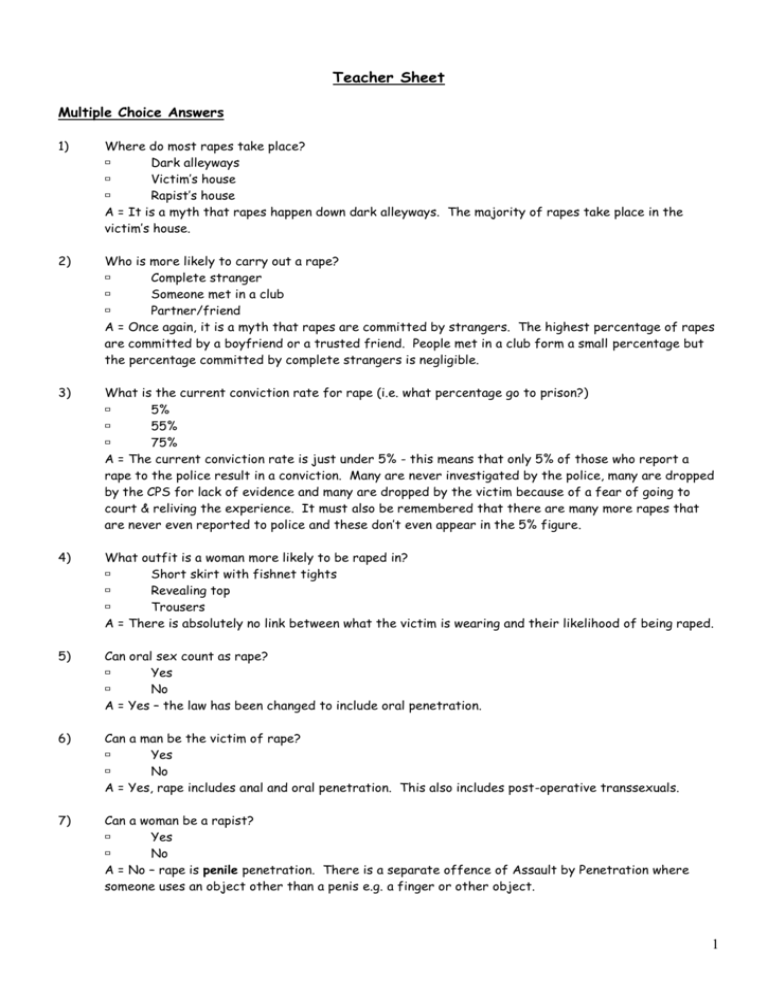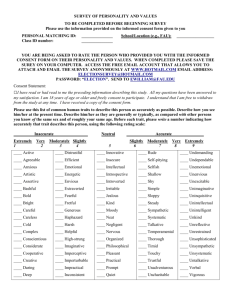
Teacher Sheet
Multiple Choice Answers
1)
Where do most rapes take place?
Dark alleyways
Victim’s house
Rapist’s house
A = It is a myth that rapes happen down dark alleyways. The majority of rapes take place in the
victim’s house.
2)
Who is more likely to carry out a rape?
Complete stranger
Someone met in a club
Partner/friend
A = Once again, it is a myth that rapes are committed by strangers. The highest percentage of rapes
are committed by a boyfriend or a trusted friend. People met in a club form a small percentage but
the percentage committed by complete strangers is negligible.
3)
What is the current conviction rate for rape (i.e. what percentage go to prison?)
5%
55%
75%
A = The current conviction rate is just under 5% - this means that only 5% of those who report a
rape to the police result in a conviction. Many are never investigated by the police, many are dropped
by the CPS for lack of evidence and many are dropped by the victim because of a fear of going to
court & reliving the experience. It must also be remembered that there are many more rapes that
are never even reported to police and these don’t even appear in the 5% figure.
4)
What outfit is a woman more likely to be raped in?
Short skirt with fishnet tights
Revealing top
Trousers
A = There is absolutely no link between what the victim is wearing and their likelihood of being raped.
5)
Can oral sex count as rape?
Yes
No
A = Yes – the law has been changed to include oral penetration.
6)
Can a man be the victim of rape?
Yes
No
A = Yes, rape includes anal and oral penetration. This also includes post-operative transsexuals.
7)
Can a woman be a rapist?
Yes
No
A = No – rape is penile penetration. There is a separate offence of Assault by Penetration where
someone uses an object other than a penis e.g. a finger or other object.
1
Definitions
Rape- intentional penile penetration of the vagina, anus or mouth without consent and without a
reasonable belief in consent.
1.
Must be with the penis so cannot be a woman
2.
Penetration only – which means no need to ejaculate– rape complete on penetration
3.
vagina, anus or mouth so includes oral sex and homosexual sex – also surgically constructed
vagina.
4.
without consent of the victim AND defendant must not have a reasonable belief in consent–
issues regarding drunken consent. The current law is as follows:
if a victim says yes, even if completely drunk and even if the defendant is fully aware
that he is taking advantage – it will not be rape because the victim has still consented
(Swansea university student case of R v Dougal in 2005 confirmed this)
if a victim is unconscious – there is an automatic presumption that the victim didn’t
consent and that the defendant did not have a reasonable belief in consent – therefore, the
burden of proof is on the defendant to prove on the balance of probabilities that he did have
a reasonable belief in consent despite her unconsciousness. Note there are sometimes issues
regarding proving that the victim was actually unconscious as in the case of R v Bree, the
judge decided that the periods that the victim claimed she was unconscious were actually just
periods of memory loss due to the intoxication.
If a victim is drugged AND the defendant was aware (doesn’t have to have
administered himself) – then once again there is a presumption of a lack of consent and a lack
of reasonable belief in consent.
If a victim is slurring and stumbling drunk and has not explicitly consented – it will
come down to whether the jury believe that the defendant had a reasonable belief in consent.
In 99% of cases, due to the prevalence of prejudice against women who get themselves drunk
and in compromising situations, the jury will say that the man was entitled to have a
reasonable belief in consent.
A reasonable belief in determined by asking whether a normal, reasonable man (Joe
Bloggs) would have a belief in consent in those circumstances. (Unfortunately the words “in
those circumstances” have lead a jury to take account of events that happened earlier in the
night e.g. buying her drinks etc.)
2
Sexual Assault – Intentionally touching another person sexually without consent and without a
reasonable belief in consent.
1.
Touching must be intentional so doesn’t include accidental touching on the train etc.
2. Touching must be sexual – currently defined as either:
Touching a reasonable person would consider sexual
Touching a reasonable person would not consider sexual but in the circumstances it would be
(i.e. a doctor inserting a finger into a vagina is not necessarily sexual touching unless the
circumstances are such that a reasonable person would consider it is sexual)
Note that this is not limited to the sexual areas BUT a reasonable person must think it is
sexual so it does not include obscure fetishes like touching of the foot!
3. Same issues regarding consent and reasonable belief in consent
Note also:
Assault by Penetration – intentional penetration of the vagina, anus or mouth with something other than
a penis without consent and without a reasonable belief in consent.
Could include body parts e.g. the finger or any other object.
Abuse of a Position of Trust – includes penetration, touching, causing them to watch sexual activity,
inciting them to carry out sexual act on themselves or others etc – anyone aged 16-18 if in a position
of trust.
Despite age of consent being 16, anyone who engages in any of above activity with 16-18 year old,
if in a position of trust will be guilty of an offence despite any consent given by the victim.
Includes all school staff, friends of family, church staff, employers, etc.
3
Scenarios
1)
The fact that Sarah let Tim buy her drinks has absolutely nothing to do with whether or not
she consented at the time of having sex.
2)
Once again, this has nothing to do with whether Sarah consented at the time of sex BUT
prejudices may start stepping in at this point and a jury may believe that she was leading him on so he
had a right to believe he was entitled to sex.
3)
Again, just because a woman consents to sexual touching does not mean that she consents to
having sex. However, a jury are likely to be convinced at this point that he would have a reasonable
belief that she was consenting to sex.
4)
Technically, as soon as Sarah told Tim to stop, she withdrew her consent so when he carried
on it became rape. BUT a jury are very likely to accept the defendant’s assertion that he had a
reasonable belief in consent.
5)
The old law that a man cannot rape his wife has been completely removed. Even though Kevin
and Tomiwa have had sex lots of times, consent must be given each time. Therefore, if she said no
this time, his only option is to say that he had a reasonable belief in consent. This will be determined
by whether a normal reasonable man (Joe Bloggs) would have a belief in consent in these
circumstances.
6)
There is still a presumption that when a man has sex with an unconscious person, that person
is not consenting and the man does not have a reasonable belief in consent. If Tomiwa decided to
report him, he would have to prove that he had a reasonable belief in consent e.g. she’d let him have
sex with her when she was asleep lots of times before.
Drunken Consent – Thinking points
1)
If she says yes, it is not rape regardless of how drunk she is.
2)
If she says no, it is non-consensual. He cannot use his drunkenness to say he had a reasonable
belief in consent. The question is whether a sober reasonable man would believe that she has
consented after she says no – which is unlikely so probably rape.
3)
If she says yes, it is not rape, regardless of how drunk she is or how much he knows he is
taking advantage. Personally, I have proposed a lesser offence in this scenario but as the law
currently stands, he will not be guilty of an offence.
4)
It will come down to whether a) the jury believe that she had the capacity to consent and b)
whether they believe he had a reasonable belief in consent – most cases indicate that he would be
able to argue a reasonable belief in implied consent if she didn’t resist.
5)
Presumption of lack of consent and lack of reasonable belief in consent if a person is
unconscious. He will have to prove that she was consenting.
4









